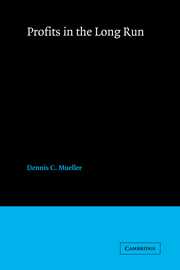Book contents
- Frontmatter
- Contents
- Acknowledgments
- 1 The persistence of firms
- 2 The persistence of profits above the norm
- 3 The persistence of market power
- 4 Profitability and market structure
- 5 The results in perspective
- 6 Profitability and the firm's own advertising, patent activity, risk, and other characteristics
- 7 Profitability and managerial control and compensation
- 8 Mergers and profitability
- 9 Mergers and market share
- 10 The threads gathered and conclusions woven
- Appendix 1 Companies studied
- Appendix 2 Industry categories
- Appendix 3 Industry matchings
- Appendix 4 Assets acquired data (Chapter 7)
- Appendix 5 Mergers and market share: samples of merging companies
- Notes
- References
- Index
8 - Mergers and profitability
Published online by Cambridge University Press: 04 May 2010
- Frontmatter
- Contents
- Acknowledgments
- 1 The persistence of firms
- 2 The persistence of profits above the norm
- 3 The persistence of market power
- 4 Profitability and market structure
- 5 The results in perspective
- 6 Profitability and the firm's own advertising, patent activity, risk, and other characteristics
- 7 Profitability and managerial control and compensation
- 8 Mergers and profitability
- 9 Mergers and market share
- 10 The threads gathered and conclusions woven
- Appendix 1 Companies studied
- Appendix 2 Industry categories
- Appendix 3 Industry matchings
- Appendix 4 Assets acquired data (Chapter 7)
- Appendix 5 Mergers and market share: samples of merging companies
- Notes
- References
- Index
Summary
The present study differs from much empirical work in industrial organization in its long-run orientation. It examines 600 firms over a 23-year time period. This long-run perspective raises an issue, however, that does not come up in the usual cross-sectional industrial organization study: To what extent is it legitimate to think of a given firm in 1972 as being the same firm that existed in 1950? In particular, this question applies to a firm such as Xerox, which in 1972, as today, was the leading photocopier manufacturer, but in 1950 was a small photographic paper manufacturer named Haloid, or to a firm like Textron, which added numerous new lines to its product mix through acquisitions between 1950 and 1972 and abandoned its original, primary line of business in textiles.
In trying to determine a criterion by which to define when a company at one point of time can be legitimately regarded as the same company that existed at an earlier point, one could take a fairly loose posture and simply say that, as long as a given company is the same legal entity, it is the same company regardless of how its product mix or name has changed. Alternatively, one could say that only when the same legal entity produces essentially the same types of products is it the same firm. Under this more stringent criterion, General Motors and United States Steel would be the same firms in 1950 and 1972; Xerox and Textron would not be.
- Type
- Chapter
- Information
- Profits in the Long Run , pp. 166 - 183Publisher: Cambridge University PressPrint publication year: 1986

